With a name like the Purple Waffle plant, there’s no doubt that this individual can be quite the conversation starter.
This plant goes by. the botanical name Hemigraphis alternata according to Iowa State University.
They are named for their unusual leaves that scrunch up in a similar shape to a waffle.
The tops of the leaves are the typical green, while underneath lays a pop of purple.
Interestingly enough, these leaves take on their shape to increase the overall surface area.
A larger leaf allows for a bigger catch of nutrients and water.
According to a Phys.org article, the Purple Waffle plant is among the highest-rated ornamental plants that reduce indoor air pollution.
PURPLE WAFFLE PLANT CARE
The purple waffle plant grows best in peat moss-based soil that is acidic with a pH between 6.1 to 6.5. Provide bright indirect sunlight. Keep the soil slightly moist and water once the soil is about to become dry. The temperature should be between 60-80°F (16-27°C). Humidity between 50-70% is optimal for this plant. Fertilize once a month with a liquid fertilizer diluted to half-strength in spring and summer.
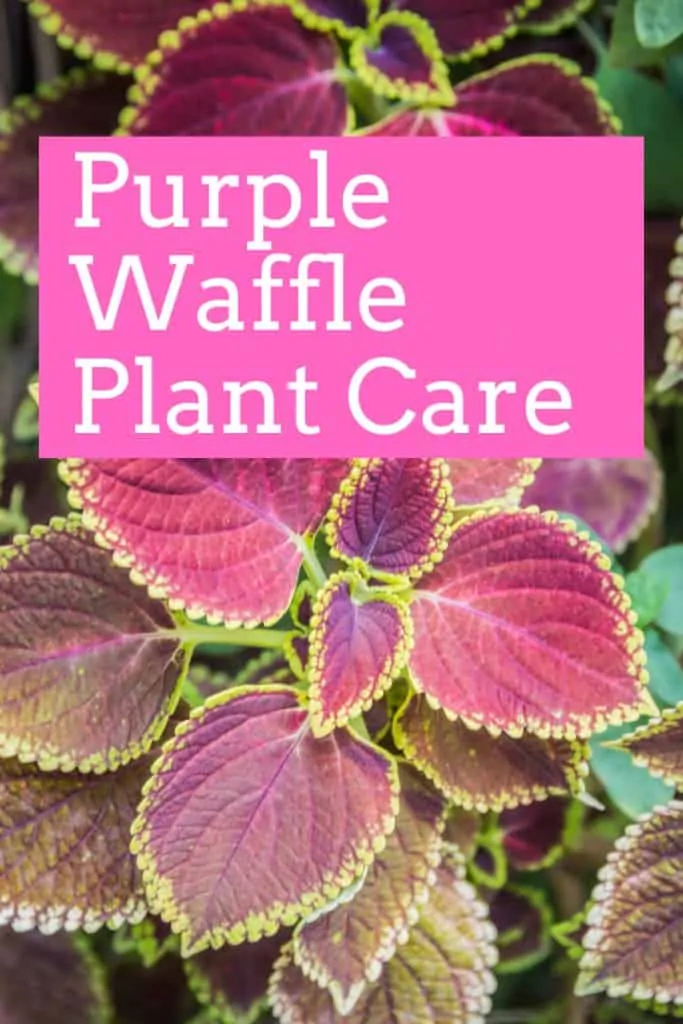
Purple Waffle Plant Care
These plants can be found naturally among the tropical regions of India, Malaysia, and Java.
Living in these climates makes them relatively hardy. Keeping them indoors makes it even easier.
In fact, many plant enthusiasts have recommended the Purple Waffle plant as being low maintenance.
Table of Contents
PURPLE WAFFLE PLANT CARE BASICS
Adding a touch of tropics into your home isn’t all that tricky if you know what to look for.
There are several components with plants to keep in mind such as how much sunlight to give them, the type of soil that you can provide, and more.
This section will highlight all of those specifications.
SOIL
The Purple Waffle plant tends to like soil that contains a fair amount of rich, organic materials such as humus.
The soil should be kept quite moist, yet not overly saturated.
Regardless of what type of mix is within the pot, be sure that there are at least a few drainage holes on the bottom.
If you’re a seasoned plant enthusiast, you may want to know about the desired pH level.
The soil should be on the acidic end, around 6.1 to 6.5 for the pH range.
Peat moss can be a great way to add some organic material to your plant.
We have an article about peat moss describing the different types and how they are beneficial!
LIGHT
The Purple Waffle plant prefers bright indirect light with a couple of hours of direct sunlight in the morning.
Just as with some other plants, the coloration of the foliage can change with how much it is exposed to light.
Too little can leave them faded, the undersides shifting from purple to dark grey.
Even getting too much can lead to damage such as bleaching or scorched leaves. The happy medium for these plants is medium to bright light exposure.
Direct sunlight can be too much for this flora.
As for where to put them in your house, we suggest a window that faces in the southeastern part of the house.
A useful tip is that direct morning sunlight can actually increase the intensity of a Purple Waffle plant’s colors when given in small doses.
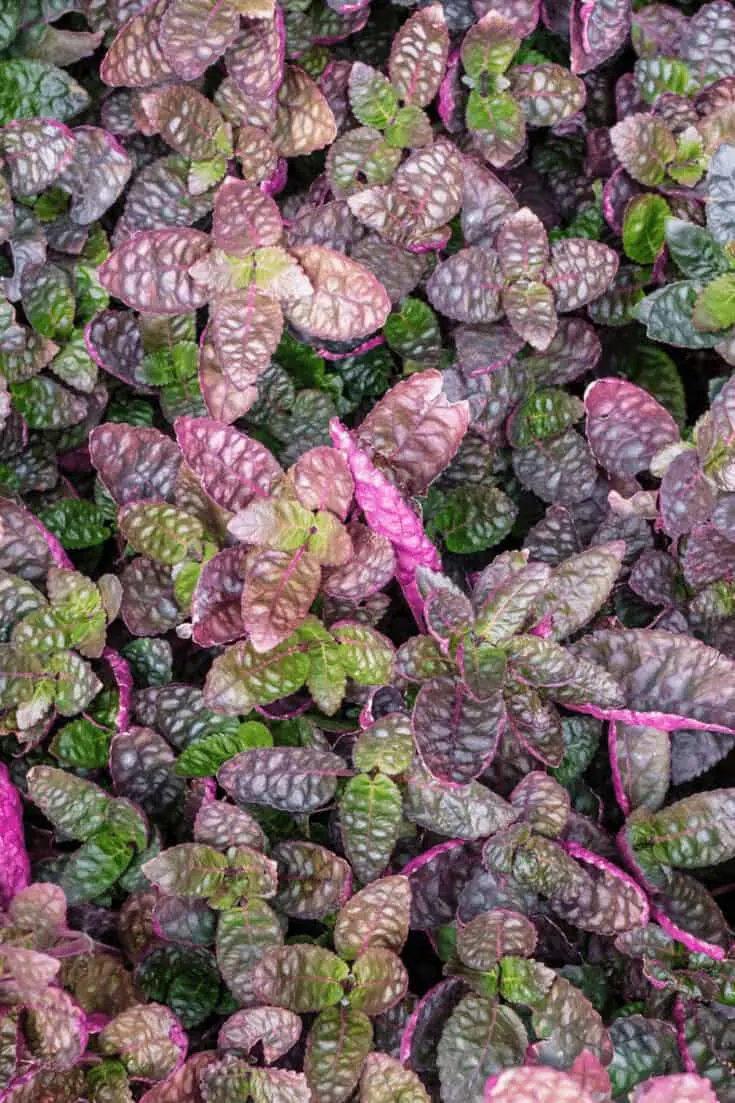
The amount of light the Purple Waffle plant gets will alter the color of its leaves. Too little can leave them faded and turn from pink to grey.
WATERING
Keep the soil slightly moist but never soggy for the Purple Waffle plant.
In order to have a happy and healthy Hemigraphis alternata, the plant should be kept consistently watered throughout the year, even in the winter.
Unlike other plants, the watering schedule should be somewhat infrequent.
This allows it to drain properly.
If a Purple Waffle plant sits in water for too long, it can quickly develop root rot.
Getting the right watering time down can be somewhat challenging.
Instead of giving you a general timeframe for when you should add moisture, we recommend that you keep an eye on the soil.
By testing the dryness of the soil, you can correctly identify when to water.
TEMPERATURE
The best temperature for the Purple Waffle plant is between 60-80°F (16-27°C).
The Purple Waffle plant is quite resilient when it comes to temperature.
Fortunately, those who keep their plants indoors tend to have few problems that are linked to this need.
Although this is a wide range, they don’t like the temperature to fluctuate too much.
Sudden drops are extremely harmful to this plant and can cause the leaves to drop.
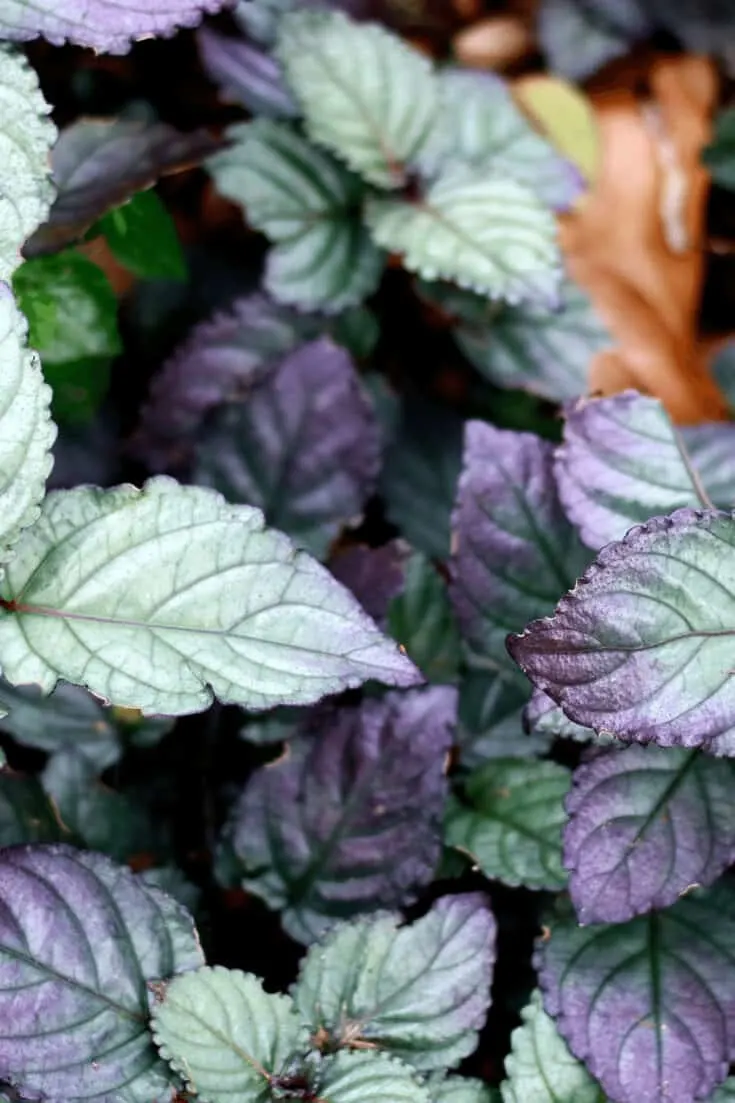
The purple waffle plant is quite tolerant to lower temperatures but does not tolerate big temperature swings
HUMIDITY
The optimal humidity for the Purple Waffle plant is 50-70%.
Hemigraphis alternata is a plant that generally flourishes in the tropical forests of
Asia where the humidity stays high throughout the year.
Even if you keep your plant indoors, you’ll want to keep the moisture level in the air on the far end.
You can achieve this through a few different ways, the easiest being a humidifier and regular misting.
Also placing your plant on a tray full of pebbles allows the water to evaporate and coat the leaves in water.
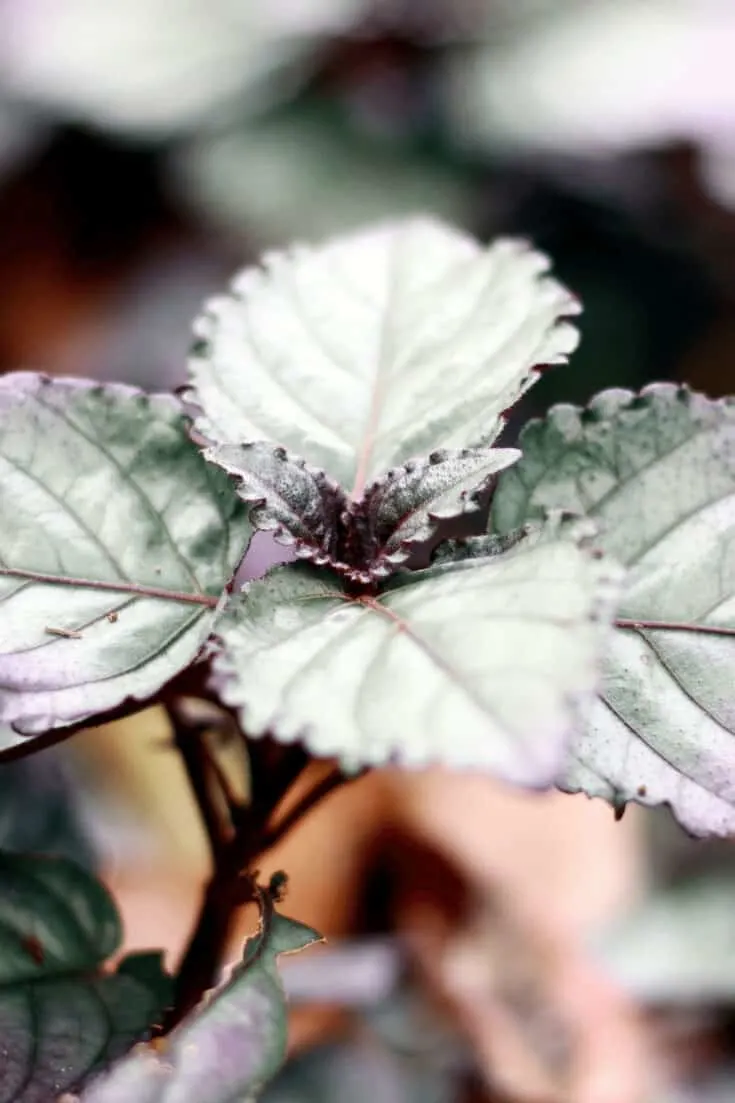
The Purple Waffle Plant thrives in high humidity
FERTILIZER
Fertilize your Purple Waffle plant once a month in spring and summer using a liquid fertilizer diluted to half of its strength.
Did you know that living among the tropics provides plants with natural fertilizer?
Interestingly enough, the leaves that fall on the ground quickly decay, providing nutrients for the flourishing ecosystem.
In your own home, the Purple Waffle plant needs a little help.
This flora does also go into a more dormant period in the fall and winter months.
You don’t need to add any fertilizer during that time.
PROPAGATION
One benefit to owning a Hemigraphis alternata is that they are able to self-propagate. We know that this is somewhat unusual compared to other plants that we’ve covered on this website.
They do this by rooting at the stem nodes. You don’t have to wait for this to happen. You can copy your beloved Purple Waffle plant through several methods of propagation, the most common being air layering and stem cuttings.
Chances are you’ve heard of stem cutting before, or perhaps have even done it.
Air layering although less well known, is really simple. But, we will discuss this in length later on.
GROWTH
These tropical plants are exceptionally fast growers, spreading out those long leaves to fill up a corner of your room. The size of a full-grown Purple Waffle plant is about 6 inches tall with an overall width of 8 inches.
They can even have a trailing spread that is about 12 to 18 inches in length. Many feel the need to trim back the stems of these floras so that they don’t become too scraggly.
POTTING
After hearing about the growth of a Purple Waffle plant, you may be concerned about the amount of repotting that you would need to do. They likely don’t need to be transferred as quickly as you think.
This will happen every few years once it has reached maturity. Some individuals don’t even need to have a transfer that frequently. It all depends on the overall health of your plant.
If you notice that the roots are cramped, then you’ll need to go through with this process. You can also opt for a larger container to allow for more room to grow. This will lessen the amount of times that you need to repot.
PURPLE WAFFLE PLANT WATER PREFERENCES
As we stated earlier, the Purple Waffle plant does like to have a good deal of water, whether that be through humidity or watering sessions.
Making sure that the soil is saturated nearly year-round will help from any catastrophic issues.
You also should keep in mind that too much water could damage the root system, leaving your vibrant flora into a wilting wonder.
To determine the right amount of watering without going overboard, we have laid out a few ways to keep your moisture addition in check.
WATERING BASICS AND ESSENTIALS
Living in the tropics means lots of rainfall and near constant humidity. When we house these plants indoors, we need to try our best to recreate the same amount of moisture.
For those who are just starting to grow their Purple Waffle plant, try to give them at least an inch of water per week. The soil should be constantly checked for dryness since this period is especially critical.
For mature individuals, try to find a schedule that is right for them with the soil only just barely drying out.
Unfortunately, there is no set schedule for Purple Waffle plants. We can’t just tell you, “Hey, you should water them once a week.”
The reason for this is that each plant is different.
It depends on where you place them in your house, or how much moisture there already is in the air.
What we can tell you to do is to check the soil. This is the best way to determine when your Hemigraphis alternata needs a watering.
FOOLPROOF METHOD: THE SOIL CHECK
You may be apprehensive when we tell you that the best way to check for dry soil is to use your finger.
Now, don’t worry. It’s easier than it sounds. Unfortunately, the Purple Waffle plant can become dried out rather quickly.
A dried-out tropical is not happy!
The way that you go about checking the soil with your finger is to stick it into the top layer of toil.
Now, these plants like to be barely dried out before being watered, keeping pretty saturated all the time.
If you feel that the top ¼ inch of soil is dry, then you know that it’s time to add a good watering.
When watering, make sure that there are at least a few drainage holes located on the bottom of your pot.
They may like plenty of water, but the roots don’t want to be sitting in that.
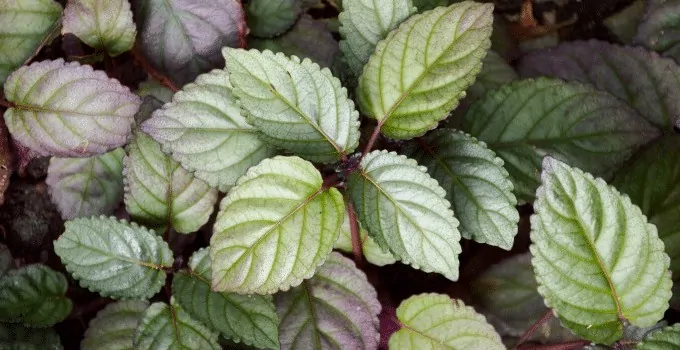
As a tropical plant, the Purple Waffle plant likes a good deal of humidity. When kept as an indoor houseplant, you may increase the humidity level by regularly misting the plant and by putting the plant on a bed of damp pebbles.
PURPLE WAFFLE PLANT PROPAGATION TECHNIQUES
You may recall us mentioning that there are two favored methods when it comes to the propagation of a Purple Waffle plant.
These are stem cutting and air layering. For a quick comparison, we’ve laid out steps to each.
PROPAGATION THROUGH STEM CUTTINGS
- Take a pair of clean scissors and make a cut along the stem so that the incision has at least one node.
- Now continue on by placing your newly cut stem into a pot with fresh soil. Watering your soil first is recommended.
- Keep your stem cutting watered until you see new growth start to happen. This is where you will transfer it to a new pot and implement a less extreme watering schedule.
PROPAGATION THROUGH AIR LAYERING
- Take a stem node from your parent plant. What we mean by this is to simply find the stem node. You don’t need to separate it yet.
- Bury your stem node into a pot with fresh soil so that it is completely covered.
- Once roots have developed, use sharp scissors to cut it away from the original plant before transferring it to its own pot.
PURPLE WAFFLE PLANT PRUNING
The Purple Waffle plant is a fast grower, quickly becoming leggy. A little bit of pruning can go a long way in keeping it from taking over a corner of your house.
These plants can be pruned at any time of the year.
Most plant enthusiasts even recommend that they be tended to and cut back at least twice a year. You can do this by pinching the tips of the leaves, or by using sharp scissors.
WHAT TO LOOK FOR IN AN UNHAPPY PURPLE WAFFLE PLANT
Do you ever wonder if these plants are susceptible to certain problems? We’ve jotted down the top two so that you can be prepared!
TELLTALE SIGN #1: DROOPING LEAVES
Cause: There can actually be a few problems linked to the drooping of leaves such as too much fertilizer, pests, or what type of pot you chose.
Remedy: If you have a ceramic pot, first switch it over to a different container. Then proceed to hold back on using fertilizer. Pests can be solved through streams of water or insecticides, but please do your research first.
TELLTALE SIGN #2: CRIPSY EDGES
Cause: Leaves that look crispy along the edges may be hinting at air that is too dry.
Remedy: Humidity can be an issue for those with these plants. You can solve these problems through implementing a more frequent misting schedule.
FIVE TAKEWAYS FOR A HEALTHY PURPLE WAFFLE PLANT
Do you wish that you could have a recap of all the essentials? Well, we’ve got them!
- Giving your tropical plant indirect light that is bright will keep it happy!
- Keep your home between 12 to 26 degrees Celsius.
- Make sure that your house stays above 15 degrees Celsius.
- Watering is huge! Just don’t oversaturate the soil.
- You can be quite liberal with your pruning efforts.
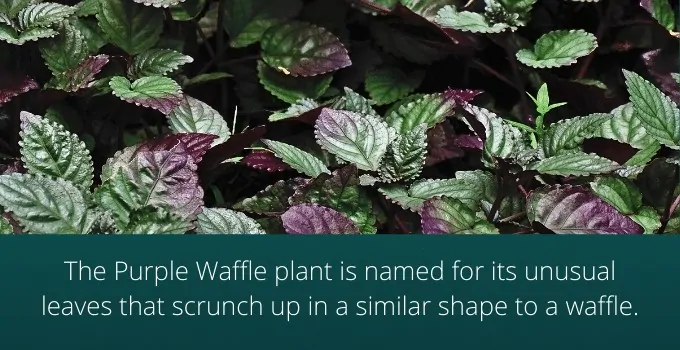
Purple Waffle Plant Name Origin
FREQUENTLY ASKED QUESTIONS ABOUT PURPLE WAFFLE PLANT
Is the Purple Waffle Plant poisonous?
This plant is non-toxic to you, your animals, and your family.
What other names does the Purple Waffle Plant go by?
The Purple Waffle Plant also goes by the Red Ivy, Cemetery plant, and the Metal Leaf.

Daniel has been a plant enthusiast for over 20 years. He owns hundreds of houseplants and prepares for the chili growing seasons yearly with great anticipation. His favorite plants are plant species in the Araceae family, such as Monstera, Philodendron, and Anthurium. He also loves gardening and is growing hot peppers, tomatoes, and many more vegetables.


